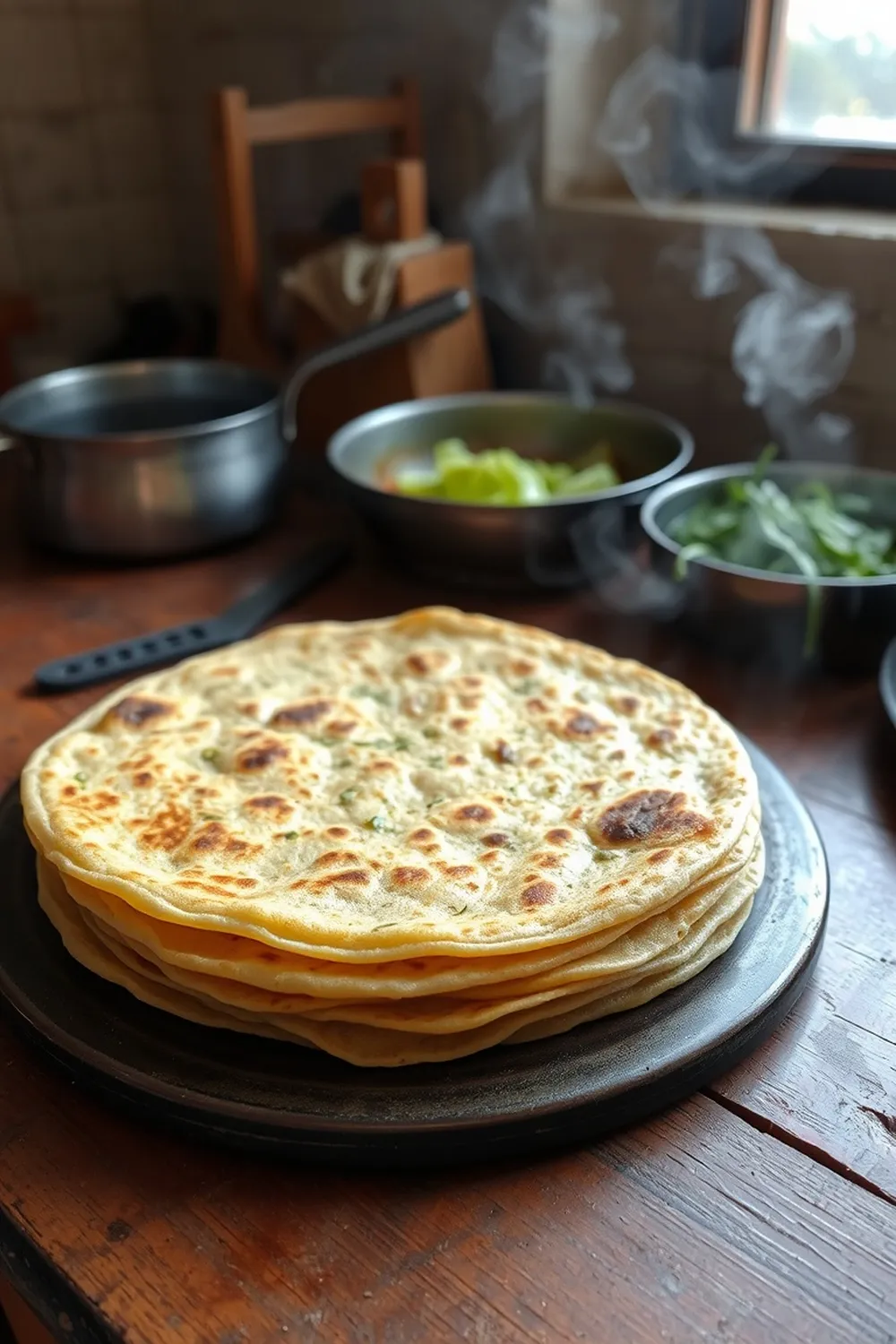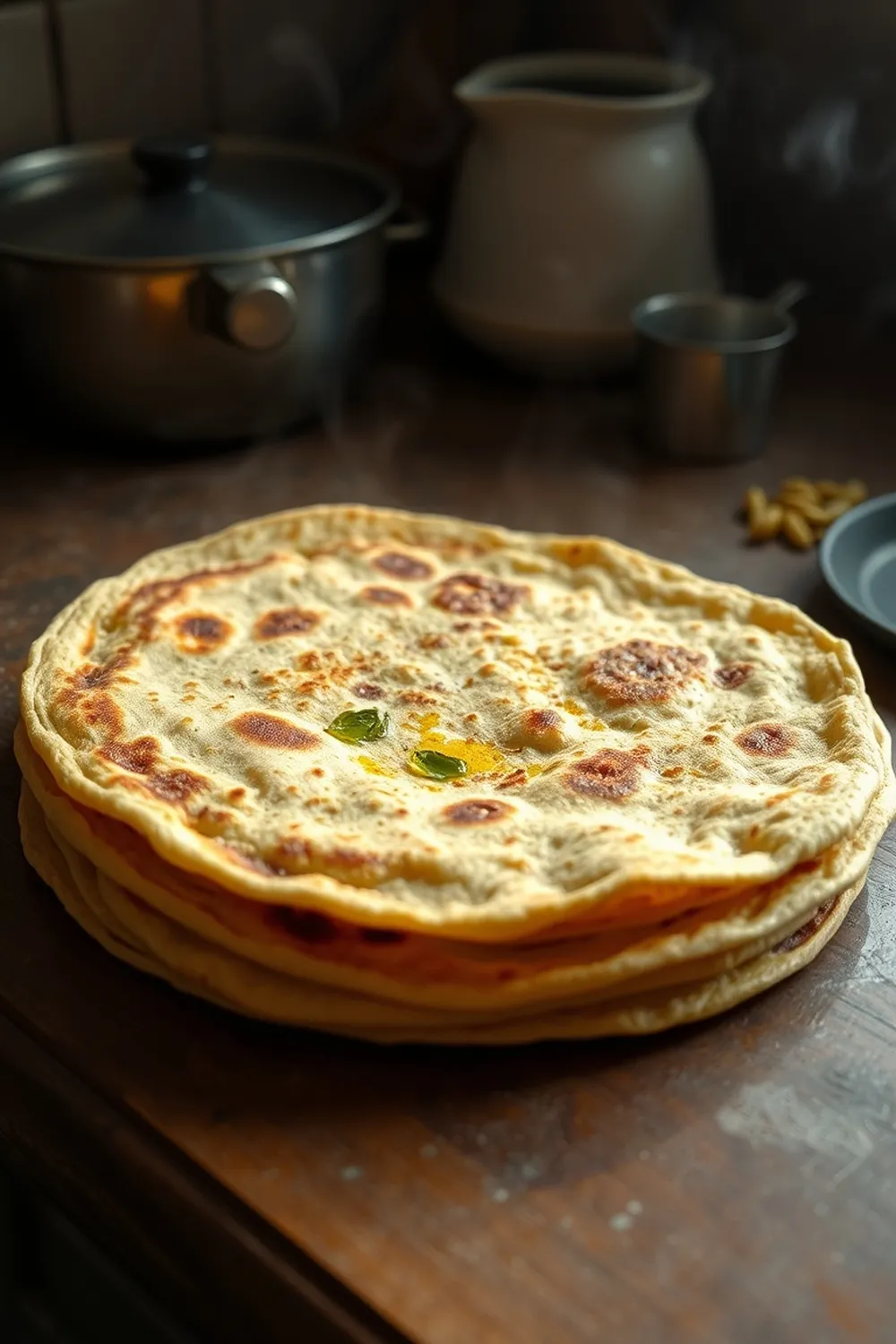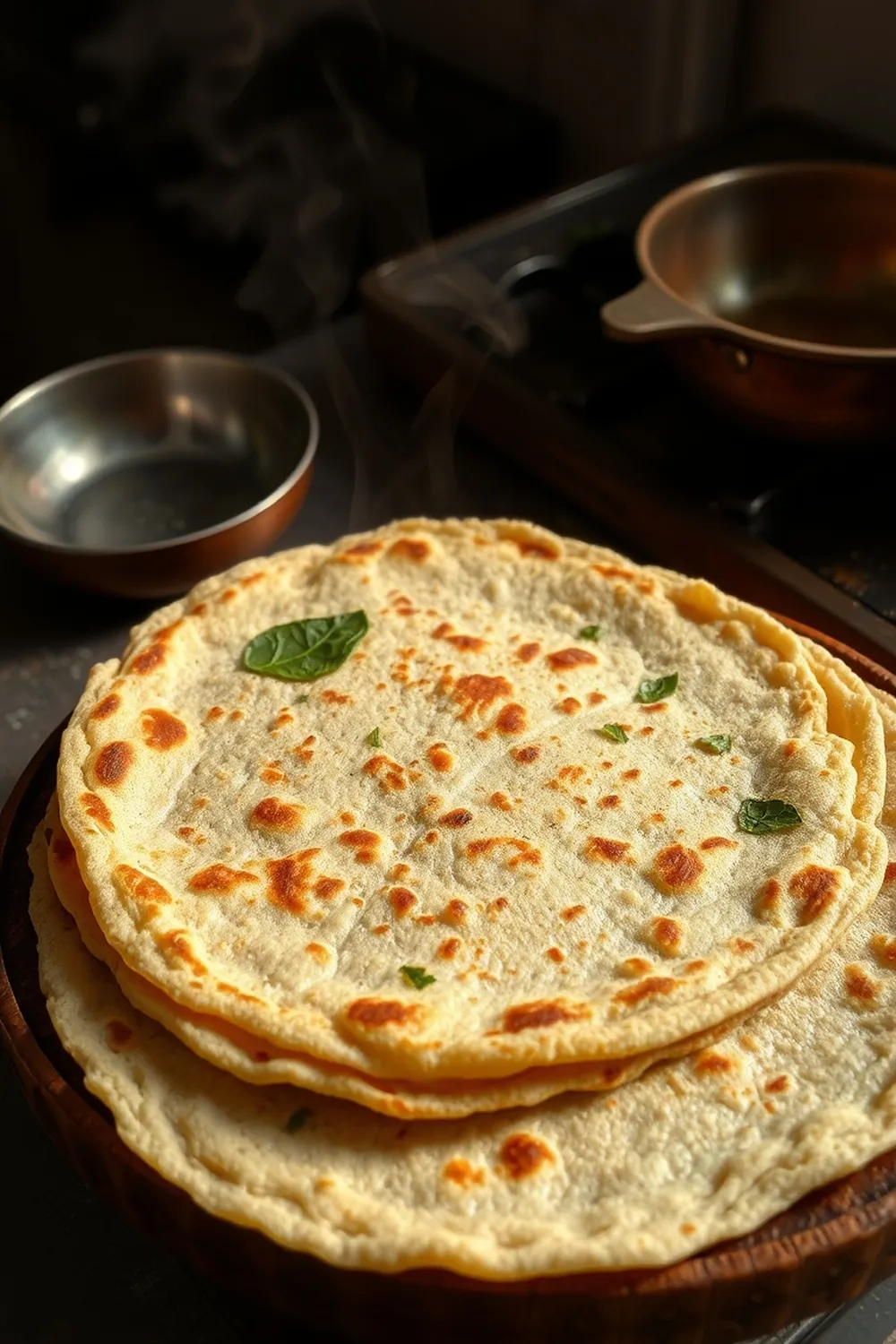- Pluck bathua leaves from stems, rinse thoroughly, and drain well.
- Cook leaves with water (and optional potato cubes) until tender.
- Combine flour, spices, and *well-drained* bathua leaves in a mixing bowl.
- Knead into a smooth dough, *if needed add water gradually*.
- Rest dough for 20-30 minutes before rolling.
- Shape into parathas using a layered folding technique.
- Cook on a hot griddle with ghee or oil until golden brown and crisp.
- Serve hot with pickles or yogurt.
- Calories:220 kcal25%
- Energy:920 kJ22%
- Protein:6 g28%
- Carbohydrates:30 mg40%
- Sugar:2 mg8%
- Salt:250 g25%
- Fat:8 g20%
Last Updated on 4 months by Neha Deshmukh
Bathua Paratha Recipe – Authentic Indian Flatbread with Winter Greens
Introduction
Oh, Bathua Paratha! This one holds a special place in my heart. It reminds me of winter mornings at my grandmother’s house, the aroma of these parathas filling the kitchen. Bathua, or Chenopodium album, is a winter green that’s incredibly good for you, and turning it into these flaky, flavorful parathas is just the way to enjoy it. Trust me, once you try these, you’ll be hooked! They’re a little bit of work, but totally worth it.
Why You’ll Love This Recipe
These aren’t just any parathas. They’re packed with nutrients, bursting with a unique earthy flavor, and incredibly satisfying. Plus, they’re a fantastic way to sneak in some extra greens – even the picky eaters in your family might not notice! It’s a comforting, wholesome meal that feels like a warm hug on a chilly day.
Ingredients
Here’s what you’ll need to make these delicious Bathua Parathas:
- 4 cups bathua leaves
- 0.33 cup water (about 80ml)
- 1 potato (optional, but adds a lovely texture)
- 2 cups whole wheat flour (atta)
- 0.5 teaspoon carom seeds (ajwain)
- 0.5 teaspoon cumin seeds (jeera)
- 1-2 green chilies, finely chopped (adjust to your spice preference)
- 1 pinch asafoetida (hing)
- 0.5 teaspoon salt (or to taste)
- 0.5 tablespoon oil
Ingredient Notes
Let’s talk ingredients! A few little tips from my kitchen to yours:
- Bathua Leaves: We’ll get into more detail about these beauties later, but make sure they’re fresh and vibrant.
- Whole Wheat Flour: I always use a good quality atta for the best texture. You want something that’s finely ground.
- Carom Seeds (Ajwain): These aren’t just for flavor! They also aid digestion, which is helpful when enjoying a hearty paratha.
- Asafoetida (Hing): A little goes a long way! It adds a lovely savory depth. Don’t skip it if you can help it.
Regional Variations in Spices
While this recipe is a classic, spice levels can vary! Some families add a pinch of turmeric for color and extra health benefits. Others like to include a dash of red chili powder for a bolder flavor. Feel free to experiment and make it your own. My aunt always adds a tiny bit of amchur (dry mango powder) for a tangy twist.
Step-By-Step Instructions
Alright, let’s get cooking!
- First, pluck the bathua leaves from their stems. Give them a really good rinse to get rid of any dirt, and then drain them well.
- Now, in a pot, cook the bathua leaves with the water (and your potato cubes, if you’re using them). Cook until the leaves have wilted down – about 5-7 minutes.
- Once cooled slightly, squeeze out any excess water from the cooked bathua leaves. You want them as dry as possible!
- In a large mixing bowl, combine the whole wheat flour, carom seeds, cumin seeds, green chilies, asafoetida, salt, and oil.
- Add the strained bathua leaves to the flour mixture.
- Now, the fun part – kneading! Start bringing the dough together. You might not need any extra water, but if it’s too dry, add a tiny bit at a time. Knead until you have a smooth, pliable dough.
- Let the dough rest for about 20 minutes. This allows the gluten to relax, making the parathas easier to roll.
- Divide the dough into equal-sized portions.
- Time for the layered folding technique! Roll each portion into a small circle, then apply a little oil and fold it like a fan. Then, gently roll it into a paratha.
- Heat a griddle or tawa over medium heat. Cook the parathas with a little ghee or oil until they’re golden brown and slightly puffed up on both sides.
Expert Tips
Here are a few things I’ve learned over the years to make the perfect Bathua Paratha:
Achieving the Perfect Paratha Texture
Don’t over-knead the dough! A slightly firm dough is better than a sticky one. And don’t be afraid to use enough oil while rolling and cooking – it’s what gives them that flaky texture.
Working with Bathua Leaves: Avoiding a Sticky Dough
This is the biggest challenge! Squeezing out all the excess water from the cooked leaves is key. If the dough still feels sticky, add a tablespoon of flour at a time until it comes together.
Mastering the Layered Folding Technique
It takes a little practice, but it’s worth it! The layers create those beautiful, flaky parathas. Watch a quick video online if you’re unsure – it helps to see it in action.
Variations
Want to switch things up? Here are a few ideas:
- Vegan Bathua Paratha: Simply use oil instead of ghee for cooking.
- Gluten-Free Bathua Paratha: Substitute the whole wheat flour with a gluten-free flour blend (like rice flour, potato starch, and tapioca starch). You might need to adjust the water content.
- Spice Level Adjustment: Reduce or omit the green chilies for a milder flavor. Add a pinch of red chili powder for extra heat.
- Festival Adaptations: These are especially popular during Holi and the winter solstice, often served as part of a larger festive meal.
Serving Suggestions
Serve these hot off the griddle with a dollop of yogurt, your favorite pickle, or a side of chole (chickpea curry). They’re also delicious with a simple cup of chai!
Storage Instructions
Leftover parathas can be stored in an airtight container in the refrigerator for up to 2 days. Reheat them on a griddle or in a pan with a little oil. They won’t be quite as flaky, but still tasty!
FAQs
Let’s answer some common questions:
What is Bathua and where can I find it?
Bathua is a leafy green vegetable that grows abundantly in the winter months. You can usually find it at Indian grocery stores or farmers’ markets during the winter season.
Can I use frozen bathua leaves for this recipe?
While fresh is best, you can use frozen bathua leaves in a pinch. Make sure to thaw them completely and squeeze out all the excess water before using.
How do I prevent the parathas from becoming hard?
Don’t overcook them! Cook them until they’re golden brown and slightly puffed up, but not crispy. Also, serving them immediately is best.
What is asafoetida (hing) and can I substitute it?
Asafoetida has a pungent aroma, but it adds a wonderful savory flavor. If you can’t find it, you can substitute it with a pinch of garlic powder, but it won’t be quite the same.
Can I make the dough ahead of time?
Yes, you can! Make the dough and store it in an airtight container in the refrigerator for up to a day. Bring it to room temperature before rolling.










